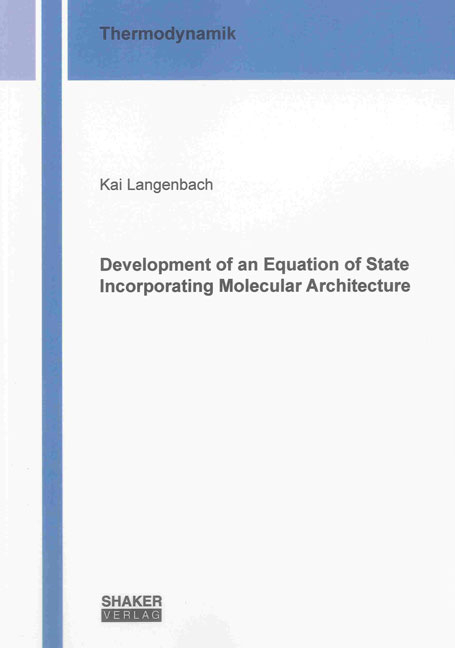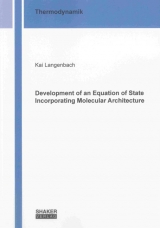Development of an Equation of State Incorporating Molecular Architecture
Seiten
2013
|
1., Aufl.
Shaker (Verlag)
978-3-8440-2119-6 (ISBN)
Shaker (Verlag)
978-3-8440-2119-6 (ISBN)
- Keine Verlagsinformationen verfügbar
- Artikel merken
The thermodynamic modelling of pure substances and mixtures has undergone large changes since the emergence of physically based equations of state that allow the description of thermodynamic properties in terms of the free energy. Most of these equations of state focus on the energetic interactions between equal or different functional groups and do not include the molecular architecture of the compounds in question other than through adjustable parameters typically fit to experimental data. For example if an isomer of a substance with similar molecular weight, but differing structure, is to be described, the whole set of parameters needs to be readjusted with this kind of theory.
However, Freed and co-workers developed the Lattice Cluster Theory in which the molecular topology of a mixture’s constituents directly enters into its free energy. As this theory is quite unwieldy in its original formulation, a simplification for engineering purposes is mandatory. Usually this simplification is performed by reducing the number of components from the multi-component case to e.g. two components and expanding the resulting equation in a series of its natural variables. In this thesis, the theory’s complexity is reduced without losing any thermodynamic information in the multi-component case, by introduction of the segmental exchange interaction energy and subsequent re-summation and expansion in a multivariate series expansion. Furthermore, the coefficients of this series expansion are simplified using some graph invariants, showing that the unphysical contributions, which scale linear with the substances’ molar mass in the original equations, cancel out exactly and the free energy only depends on a small subset of combinatorial numbers describing the molecular architecture. The newly developed equation of state is used to perform some theoretical calculations concerning the influence of molecular topology on thermodynamic behaviour. Afterwards the theory is applied to phase equilibria of pure compounds, binary and ternary mixtures. The influence of branching on vapour pressure is predicted correctly for the case of alkane isomers. Vapour-liquid equilibria are also investigated for binary mixtures and the proposed mixing rules correctly capture the phase behaviour. Liquid-liquid equilibria are investigated for binary and ternary mixtures in the compressible and incompressible case. In the incompressible case the upper critical solution temperature of the solution of branched polyethylene in diphenyl ether is predicted correctly for different molar masses. In the compressible case, the phase behaviour of two hyper-branched polymers in different solvents is calculated and vapour-liquid, liquid-liquid, as well as vapour-liquid-liquid behaviour is described in good agreement with experiment.
However, Freed and co-workers developed the Lattice Cluster Theory in which the molecular topology of a mixture’s constituents directly enters into its free energy. As this theory is quite unwieldy in its original formulation, a simplification for engineering purposes is mandatory. Usually this simplification is performed by reducing the number of components from the multi-component case to e.g. two components and expanding the resulting equation in a series of its natural variables. In this thesis, the theory’s complexity is reduced without losing any thermodynamic information in the multi-component case, by introduction of the segmental exchange interaction energy and subsequent re-summation and expansion in a multivariate series expansion. Furthermore, the coefficients of this series expansion are simplified using some graph invariants, showing that the unphysical contributions, which scale linear with the substances’ molar mass in the original equations, cancel out exactly and the free energy only depends on a small subset of combinatorial numbers describing the molecular architecture. The newly developed equation of state is used to perform some theoretical calculations concerning the influence of molecular topology on thermodynamic behaviour. Afterwards the theory is applied to phase equilibria of pure compounds, binary and ternary mixtures. The influence of branching on vapour pressure is predicted correctly for the case of alkane isomers. Vapour-liquid equilibria are also investigated for binary mixtures and the proposed mixing rules correctly capture the phase behaviour. Liquid-liquid equilibria are investigated for binary and ternary mixtures in the compressible and incompressible case. In the incompressible case the upper critical solution temperature of the solution of branched polyethylene in diphenyl ether is predicted correctly for different molar masses. In the compressible case, the phase behaviour of two hyper-branched polymers in different solvents is calculated and vapour-liquid, liquid-liquid, as well as vapour-liquid-liquid behaviour is described in good agreement with experiment.
| Erscheint lt. Verlag | 7.8.2013 |
|---|---|
| Reihe/Serie | Berichte aus der Thermodynamik |
| Sprache | englisch |
| Maße | 170 x 240 mm |
| Gewicht | 213 g |
| Einbandart | Paperback |
| Themenwelt | Technik ► Elektrotechnik / Energietechnik |
| Schlagworte | Ingenieurwissenschaften • Kraftwerktechnik • Thermodynamik |
| ISBN-10 | 3-8440-2119-1 / 3844021191 |
| ISBN-13 | 978-3-8440-2119-6 / 9783844021196 |
| Zustand | Neuware |
| Haben Sie eine Frage zum Produkt? |
Mehr entdecken
aus dem Bereich
aus dem Bereich
DIN-Normen und Technische Regeln für die Elektroinstallation
Buch | Softcover (2023)
Beuth (Verlag)
86,00 €
Kolbenmaschinen - Strömungsmaschinen - Kraftwerke
Buch | Hardcover (2023)
Hanser (Verlag)
49,99 €




